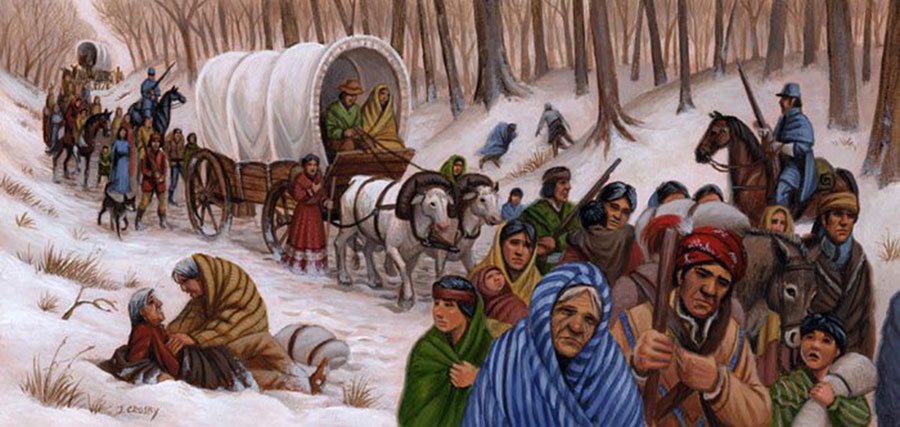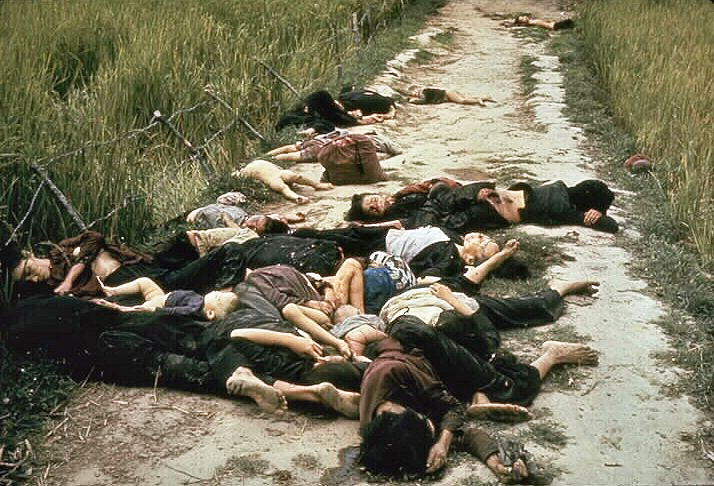“Why Does the U.S. Military Celebrate White Supremacy?”—A Short Answer, a Short History
| revcom.us
Editor's Note: This a revised version of an article originally rush-published on Monday, May 25, 2020. Minimal edits have been made for accessibility and focus.
The New York Times published an editorial yesterday, Sunday, May 24, with the title “Why Does the U.S. Military Celebrate White Supremacy?”1 The editorial questions, exposes and condemns the long-standing naming of U.S. military bases with names and figures drawn from the white-supremacist slave-upholding Confederacy, including some of the largest and most “storied” like Fort Benning and Fort Bragg—and righteously urges their renaming.
This is indeed an ugly reality—and it is positive that the NY Times editorial is highlighting this, especially in the age of Trump-Pence, and their regime’s openly white-supremacist rhetoric, acts, program and social base. It is significant that the Times IS exposing this ugly and outrageous reality—hiding in plain sight—on Memorial Day! And it is positive that there has been a movement to remove the names and monuments to the Confederacy in the last few years since the murder of nine Black churchgoers in Charleston, South Carolina, by white-supremacist Dylann Roof.
But, at the same time, the NY Times completely omits the far more fundamental truth, that the question of white supremacy and its celebration in the military is not just limited to the Confederate scum criticized by the Times. Since the founding of this country, white supremacy has been interwoven into its history, and with the fabric of this society and its system of capitalism—and the U.S. military, in imposing the rule of this oppressive and exploitative system and carrying out its objectives, is a concentration of this country and system’s attributes, morality and goals. This defining feature has found particular expression as the U.S. has become a global power presiding over the system of capitalism-imperialism, ruthlessly dominating parts of Latin America, Africa, the Middle East and Asia with unprecedented brutality and horrific violence, largely carried out against non-white peoples in the service of American imperialism.
The NY Times omits and glosses over the essence of the U.S. military, obscuring the more fundamental truth about the U.S. military, its history, its acts, and its purpose.
The U.S. Military—Origins Soaked in White Supremacy
Bob Avakian has said:
This system in this country was founded in genocide and slavery. From the beginning, African-Americans and Native Americans were treated as “pariahs,” a caste of people less than human and not deserving of the same rights and opportunities as the European settlers of the territory. White supremacy was poured into the foundation and into every institution of the country.2
The U.S. military is one of the main enforcers of the rule of this system, and one of its main instruments in carrying out its objectives. The U.S. military has a “storied” history in the slavery of Black people and the genocide of Native Americans, from the time of George Washington. Washington—with fellow slave-holders and upholders of slavery like Thomas Jefferson and others—forged the U.S. Army out of the Continental Army that defeated the British in the Revolutionary War for Independence, and was its first general and the country’s first president.
During this war and soon after, the U.S. Army waged a campaign of extermination of Indians, such as in New York (against the Onondagas and the Iroquois) and Ohio (against the Moravian Indians), justifying them as revenge for supposed Indian atrocities, making the frontier safe for settlement and taking British allies out of the war.3 This campaign of genocide against the Native peoples then continued, accelerating in scope, scale and geography as the U.S. expanded westward. There were particularly horrendous campaigns. The U.S. military enforced the Indian Removal Act in 1830 that forcibly relocated East Coast tribes across the Mississippi, with about 5,000 dying in the Trail of Tears,4 with the army deliberately routing the march through areas of known cholera epidemic. There were a number of massacres carried out during the American Indian Wars, in particular the 1864 Sand Creek massacre, where 130 peaceful Cheyenne and Arapaho were massacred, two-thirds women and children. The U.S. Army men took Indian scalps, fetuses and genitalia as trophies.5
This is the ugly history of the U.S. military.
With the brief exception of the Civil War and Reconstruction that followed,6 the U.S. military, as concentrating the monopoly of legitimate armed force, has been a bulwark of enforcement of the oppression of Black people throughout the slave South. The NY Times in its editorial acknowledges the “toxic legacy” of the Confederacy in the naming of 10 major military installations in the South, namings that “reflect a federal embrace of white supremacy that found its most poisonous expression in military installations where black servicemen were deliberately placed under the command of white Southerners—who were said to better ‘understand’ Negroes—and confined to substandard housing, separate transportation systems and even ‘colored only’ seating in movie houses.”
At the same time, Black soldiers after Reconstruction were marshaled in the genocidal wars against Native peoples, most infamously as the Buffalo Soldiers, Colin Powell’s7 celebrated heroes.
This is the ugly history of the U.S. military.
Bob Avakian has said:
White supremacy and capitalism—they have been completely interwoven and tightly “stitched together” through the whole development of this country, down to today; to attempt to really put an end to white supremacy while maintaining the system of capitalism would tear the entire fabric of the country apart.8
The very fact that it has been more than 150 years since the end of the Civil War and the defeat of the Confederacy—and this naming of bases after Confederate generals remains a continuing practice in the South—is testament to how integral and inter-woven open white supremacy is in the U.S. military—and the system it represents and enforces.
The U.S. Military—A Global Instrument of Wars, Massacres, Violence and Torture
First, with the Mexican American war in 18469 that resulted in the acquisition of large amount of territory that is now modern day Texas and the Southwest, and with the Spanish-American war in 1898,10 the U.S. embarked on the path to becoming a world imperialist power, taking a big leap after it emerged after World War II as the top-dog imperialist power, displacing Britain.
This ascendance and juncture was marked by the dropping of atomic bombs on Hiroshima and Nagasaki, killing more than 200,000 civilians, with the U.S. becoming the only country in history to have used nuclear weapons. Major General Curtis E. LeMay, who directed the bombing of Japan and relayed President Truman’s order to drop nuclear bombs, commented “If we’d lost the war, we’d all have been prosecuted as war criminals.”11
And he was right, with the U.S. military going on to commit unprecedented war crimes and crimes against humanity—under both Democratic and Republican presidents and administrations—as it strove to achieve and maintain dominance globally, ravaging parts of the Third World, with abandon and without apology. When Obama visited Hiroshima during his presidency, the only debate within the Obama team was over how to make sure the trip wasn’t seen as an apology!
This is the ugly history of the U.S. military.
It is simply beyond the scope of this article to document the entire history of horrors committed by the U.S. military, mostly against the non-white populace of the Third World—for there is no precedent and there are not enough pages. But it is a history filled with the tears and the blood—of civilians, in Iraq and in Afghanistan, in Iran and in Libya, in Vietnam and in Cambodia, in the Philippines and in Cuba, in El Salvador and in Haiti, in the Dominican Republic and in Panama, in Korea and in Indonesia… and the list goes on and on… and on and on… and on and on.
In terms of sheer numbers, it is hard to match even the extremely conservative estimates for the number of civilian deaths and bombings that the U.S. military is responsible for—2 million Vietnamese over the course of the war in Vietnam, 500,000 to a million in Iraq and Afghanistan, more than 100,000 tons of explosives dropped in Cambodia over the course of little more than a year, a country less than half the size of California! Even within this ugly history, the massacre at My Lai in Vietnam stands out—more than 500 people killed, including young girls and women who were raped and mutilated.12
This violence—of horrific scale and scope—has been integrally bound up with white-supremacy, labeling Asians as “gooks” and “slopes,” Arabs as “sand-niggers” and other racist terms that dehumanize the “enemy” of U.S. imperialism, whoever they be at a given time, rendering them “sub-human” and enabling acts of horrors like My Lai. Much of this has been done in the name of “spreading democracy.”13 But as Bob Avakian has said:
The essence of what exists in the U.S. is not democracy but capitalism-imperialism and political structures to enforce that capitalism-imperialism. What the U.S. spreads around the world is not democracy, but imperialism and political structures to enforce that imperialism. (BAsics 1:3)
What is needed is sweeping this system off the face of this planet through an actual revolution. For more, go to Bob Avakian's talk, Why We Need An Actual Revolution And How We Can Really Make Revolution.
1. Why Does the U.S. Military Celebrate White Supremacy? By the Editorial Board, New York Times, May 23, 2020. [back]
2. Why We Need An Actual Revolution And How We Can Really Make Revolution, a speech by Bob Avakian. [back]
3. American Crime Case #90: The Sullivan Expedition, 1779— Genocide of Native Peoples and Scorched Earth in Upstate New York, revcom.us, July 4, 2016. [back]
4. American Crime Case #44: The Trail of Tears, 1838-39, revcom.us, February 19, 2018. [back]
5. American Crime Case #56: The 1864 Sand Creek Massacre, revcom.us, October 30, 2017. [back]
6. During the Civil War, the U.S. Army was the “Union Army,” fighting to preserve the Union against the slave-upholding Confederate states that had declared secession. With the victory of the Union Army (with the participation of Black soldiers released from slavery through the course of the war, with Lincoln’s Emancipation Proclamation), this led to the abolition of slavery.
Following this was the period of Reconstruction and betrayal, which Bob Avakian has characterized the following way in How This System Has Betrayed Black People: Crucial Turning Points:
In the period after the Civil War, during the very short-lived experience of Reconstruction—this was a period that lasted really for only about ten years, more or less from 1867 to 1877—the federal army, the Union army, remained in the South after the war as the enforcers of very real and significant reforms that were carried out, both in the economic base and in the political superstructure.
Today you see the Spike Lee films, and they have a reference to "forty acres and a mule"—this was the promise of land (and the basic means to work the land) that was made to Black people during the Civil War. Land ownership was at that time crucial for Black people to have as some kind of economic "anchor" and basis for them to resist being forced back into conditions of virtual if not literal slavery, of serf-like oppression, on the southern plantations.
Along with "forty acres and a mule," other economic and political rights were promised to Black people. And in fact during the brief period of Reconstruction, while the full promise of these rights was never realized, there were significant changes and improvements in the lives of Black people in the South. The right to vote and to hold office, and some of the other Constitutional rights that are supposed to apply to the citizens of the U.S., were partly, if not fully, realized by former slaves during Reconstruction. And in fact some Black people were elected to high office, though never the highest office of governor, in a number of southern states.
This was very sharply contradictory. The armed force of the state, as embodied in the federal army, was never consistently applied to guarantee these rights, and in fact it was often used to suppress popular struggles aimed at realizing these rights. But there was a kind of a bourgeois-democratic upsurge in the South during this period, and it not only involved the masses of Black people but also many poor white people and even some middle class white people in the South. During these ten years of Reconstruction, with all the sharp contradictions involved, there was a real upsurge and sort of flowering of bourgeois-democratic reforms. This was not the proletarian revolution, but at that time it was very significant.
In 1877, all this was reversed and betrayed. The bourgeoisie had gotten what it needed out of this situation: it had consolidated its hold over the country as a whole; it had consolidated its dominant position economically and politically within the South as well as the North and West.
Many of the old plantation owners were now beginning to move back in and take control of their own plantations, now involving exploitation in basically a feudal (or semi-feudal) form, and millions of Black people in particular were forced into sharecropping and similar relations of exploitation and were reduced to a serf-like condition, which was enforced by a whole system of legal and extra-legal terror. At the same time, banking and other capital from the North had bought into much of the southern economy and was intermingled with the plantation system, as well as other facets of the southern economy, on many different levels. So this whole bourgeois-democratic upsurge that marked Reconstruction was beginning to be a serious threat to the bourgeoisie, as well as to the southern planters. The northern-based capitalists had less and less interest in protecting, or even tolerating, this upsurge. They certainly didn't want to see it continue to grow and perhaps get out of their control more fully.
So in 1877 something very dramatic happened. The federal army was withdrawn from the South and the masses of Black people were stripped of even the partial economic and political gains they had made and were subjugated in the most brutal ways and once again chained to the plantations, only now essentially in peonage instead of outright slavery. And the federal troops that were withdrawn from the South were immediately used in two ways: one, to crush major strikes of what at that time was essentially a white labor movement; and two, to carry further the genocide against the Indians and to finish the job of driving those who survived into these concentration camps of poverty called "reservations" and force them to stay there. Here, once again, we see a very dramatic example of how the ruling class divided and conquered different groups of people it oppressed. And one of the sharpest examples, and real tragedies, of this is how some Black people became Buffalo soldiers fighting the Indians at the very time that Reconstruction was being betrayed.
But the larger point I am emphasizing is that here was a situation involving a major turning point in U.S. history where the question was posed very decisively: Can Black people and will Black people actually be "absorbed," or integrated, or assimilated into this society on a basis of equality? Will not only slavery, but the after-effects of slavery, be systematically addressed, attacked and uprooted…or not? And the answer came thunderously through—NO!—this will not be done. And there was a material reason for that: it could not be done by the bourgeoisie without tearing to shreds their whole system. [back]
7. Colin Powell is a war criminal many times over. He committed towering war crimes and crimes against humanity in his role as a top U.S. military official in the first war against Iraq, in 1991, which led to the deaths of tens of thousands of Iraqis and the destruction of much of Iraq’s civilian infrastructure—which in turn led to many more deaths. See Colin Powell–And His Endorsement of Obama. [back]
8. Why We Need An Actual Revolution And How We Can Really Make Revolution, a speech by Bob Avakian. [back]
9. American Crime Case #83: The U.S.-Mexico War of 1846-1848, revcom.us, August 30, 2016. [back]
10. American Crime Case #58: U.S. Conquest of the Philippines 1899-1902, revcom.us, October 9, 2017; and American Crime Case #59: The U.S. Invasion, Occupation, Domination, and Plunder of Cuba: 1898 to 1959, revcom.us, October 2, 2017. [back]
11. American Crime Case #97: August 6 and 9, 1945—The Nuclear Incineration of Hiroshima and Nagasaki, revcom.us, May 23, 2016. [back]
12. American Crime Case #96: Vietnam, March 16, 1968—The My Lai Massacre, revcom.us, May 23, 2016; David Corn, Colin Powell’s Vietnam Fog, The Nation, May 2, 2001. [back]
13. To enforce this system, its rule and structures, it is hard to match what the U.S. military has pioneered and led in torture and wanton cruelty, in coups and massacres—in the service of U.S. imperialism. As an example, the U.S. Army has run a School of the Americas (SOA) since 1946 till recently, in Fort Benning (named after a Confederate general) training military officers from countries all over Latin America, “friendly” countries and regimes carrying out U.S. bidding. As the American Crime Case #91 on the SOA states, “The school’s curriculum includes sniper training, commando and psychological warfare, military intelligence, and interrogation tactics—including the use of torture, rape, disappearances, assassinations, and mass killings”—put into service in Guatemala, Honduras, El Salvador, Nicaragua, the Dominican Republic, Argentina, Chile and many others by military officers trained at the SOA, affecting hundreds of thousands. (American Crime Case #91: School of the Americas—Training Ground for Mass Murderers and Torturers, 1946-Present, revcom.us, June 27, 2016.)
As the American Crime piece on the SOA states, “A former political prisoner in Paraguay described how a section of these manuals gives ‘interrogators’ instructions on ‘how to keep electric shock victims alive and responsive’ and ‘recommends dousing the victims’ heads and bodies with salt water, and includes a sketch showing how this ‘treatment’ should be carried out.”
This is the ugly history of the U.S. military. [back]


Clip: The direct line from the Confederacy to the fascists of today

Get a free email subscription to revcom.us:


 Trail of Tears
Trail of Tears
